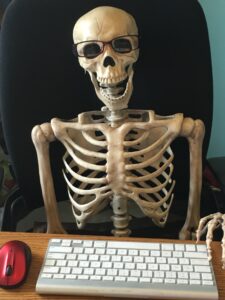This is the last in an ongoing series entitled ‘Vacationing with Death: What I did this Summer’.
You know it’s love when your LOYL agrees to come to the cemetery with you while you’re on holiday. Hepburn and I toured Sandon’s cemetery while my patient partner hung back, reading/napping in the shade. It was a lovely way to end our day at Sandon, BC considering all that we had learnt about its tragic histories. We decided to call on this overlooked place after visiting the Sandon Museum basement. And what a basement! We just had to go down those wide stairs into the blackness. It was dark, and dank, and musty, and purported to have ghosts (don’t even get me started about the rhythmic banging noise that only started when I was left alone and stopped when I went up the stairs!).
Ghost thumping aside, I was duly surprised to find an out-of-the-way exhibit of original tombstones from Sandon Cemetery and its accompanying ‘Restoration Report’ from 1996.

A rich historical document, The Restoration Project Report outlined some of the history of the residents of the cemetery, the evolution of it and the need for conservation. Hence the wooden tombstones in the Museum’s basement. It seems Dark Tourists were removing them from their places in the cemetery, leaving the residents without memorials: unnecessarily cruel, and selfish.


Cemeteries are a relatively new concept; relative in relation to the history of humans dying, that is. And also, nascent in terms of how we care for our dead because cemeteries are NOT graveyards or churchyards. Churchyards came first, then cemeteries. The difference being graveyards tended to be smaller areas for burials, churchyards are, as the word indicate, yards for burials near churches, and cemeteries, as we know (and love) them, began a little over 200 years ago, one of the most famous being the 1804 Cimetière de Père-Lachaise in Paris.
Laqueur (2015) notes that as far back as records go people were buried outside of the cities in the Mediterranean, the seat of western society. They were buried ‘away from the gods’ (94). Cicero (106BC – 43BC), Roman politician, lawyer and orator, traced the prohibition of burial inside city walls to 5th C BCE laws, and 3rd C BCE that explained the dead would pollute sacred spaces, i.e., temples and shrines to gods and deities and well into the 5thC CE Justinian’s code of law continued to prohibit burial inside the city spaces. It should be noted that burials at this time were not segregated. As late as the 5th C CE Jews, Christians, and Pagans were still buried in the same ground, side by side. Charlemagne – Charles the Great, King of Franks from 768CE, and unifier of Europe during the early Middle Ages, forbade the use of pagan cemeteries, and gave the Church (i.e., the Catholic Church) exclusive claims to the dead. Burial in church yards still took centuries as churches were slow to be built and many peasants and rural citizens were buried on their own properties. However, the separation of burial based on religion had taken hold. So, what is a cemetery and why visit it on a date with your LOYL?
Cemeteries in the 19th century were built on the outskirts of busy towns and cities. They were designed to resemble Elysium or Acadia, the ancient mythological landscapes inhabited by the dead and visited by shepherds. Victorian cemeteries were landscaped and designed to encourage visitors, not just those mourning their loved ones buried in them, but socialites who would promenade with potential suitors along the winding paths, or sit under the canopied trees on a pleasant spring day with family. And Sandon fits this design, in a neglected sort of manner.

Located outside of the town centre to the east side of the road one would miss it if not looking for its renovated white picket fence. Nestled in the forest, the dead rest, silently, all but neglected by a few who venture there. With the grave markers now safely stored in the Sandon Historical Society Museum, my visit highlighted the few remaining known grave sites marked by contemporary cement construction blocks. But one still has a broken wrought-iron fence about it and towards the far side away from the entrance I had to walk carefully around the grave site divots – the areas where the ground collapsed as the remains decomposed and shifted.
As I walked the grounds, under the canopy of pine trees, the cool breeze rustling the foliage, I was mindful that this space is sacred: a place set apart and immortalized. It possesses the traces of lives lived and loved, and is a physical reminder that death becomes us all.
Resources and further reading:
Laqueur, T.W. “The Work of the Dead”. The Churchyard and the Old Regime. Princeton, NJ: Princeton University Press.
Stevens Curl, James. The Victorian Celebration of Death. David + Charles Publishers. 1972.
Ask a Mortician has done several videos on cemeteries and I highly recommend her interview with Dr. Kami Fletcher (of Radical Death Studies) on racial segregation of the dead in the USA. https://www.youtube.com/watch?v=W4-0iAzFIcI
#radicaldeathstudies #cemeteries #datenight #askamortician #Sandon #deathpositive #deathpositivity #hepburnskeleton #artanddeath #deathandart #mementomori #letstalkaboutdeath #mortalwayfaring #ghosttownsBC #canadianhistory #summervacation #deathandart #darktourism #sandonbc

















